How Are Smart Assistants Changing the Online Shopping Experience? Smart assistants like Alexa and Google…

Applying Blue Ocean Strategy in SEO for Digital Marketing
Applying Blue Ocean Strategy in SEO for Digital Marketing
Applying Blue Ocean Strategy to SEO in digital marketing can create new opportunities and competitive advantages. By identifying untapped market spaces and innovating your approach, you can significantly enhance your online presence and attract a wider audience. Here are specific strategies to apply Blue Ocean principles to your SEO efforts in 2024.
Blue Ocean Strategies in SEO
- Identify Underserved Keywords
- Keyword Research: Use tools like Ahrefs, SEMrush, and Google Keyword Planner to find low-competition, high-potential keywords. Focus on long-tail keywords that address specific needs or questions within your niche.
- Gap Analysis: Conduct a content gap analysis to identify topics that your competitors haven’t covered. Create comprehensive content to fill these gaps and attract a new audience.
- Innovate Content Formats
- Interactive Content: Develop interactive content such as quizzes, calculators, and infographics that engage users and encourage sharing. Tools like Canva and Typeform can help create these formats.
- Video SEO: Optimise video content for search engines by including relevant keywords in titles, descriptions, and tags. Use platforms like YouTube and Vimeo to host and distribute your videos.
- Leverage Emerging Technologies
- Voice Search Optimisation: With the rise of voice-activated devices, optimise your content for voice search by using natural language and conversational queries. Focus on question-based keywords and provide clear, concise answers.
- AI and Machine Learning: Utilise AI tools like BrightEdge and MarketMuse to analyse search trends, predict keyword performance, and generate data-driven content strategies.
- Focus on Local SEO and Micro-Moments
- Local SEO: Optimise your website for local searches by creating and optimising Google My Business listings, encouraging customer reviews, and using local keywords. This is especially effective for businesses targeting specific geographic areas.
- Micro-Moments: Capture micro-moments by creating content that addresses immediate needs and queries of users. These are moments when users turn to their devices for quick information, making it crucial to provide fast, relevant answers.
- Build Strategic Partnerships and Backlinks
- Collaborative Content: Partner with non-competing brands to co-create content that provides value to both audiences. This can include guest blogs, joint webinars, and cross-promotional campaigns.
- High-Quality Backlinks: Focus on earning backlinks from authoritative websites in your industry. This can be achieved through outreach, creating link-worthy content, and leveraging relationships with industry influencers.
- Optimise for Mobile and Page Experience
- Mobile-First Indexing: Ensure your website is mobile-friendly by using responsive design, fast loading times, and easy navigation. Google’s mobile-first indexing prioritises websites that perform well on mobile devices.
- Core Web Vitals: Improve user experience by optimising Core Web Vitals, which include loading speed, interactivity, and visual stability. Tools like Google PageSpeed Insights and Lighthouse can help assess and improve these metrics.
Conclusion
By applying Blue Ocean Strategy to your SEO efforts, you can uncover new opportunities and reduce competition. Focusing on underserved keywords, innovating content formats, leveraging emerging technologies, optimising for local SEO and micro-moments, building strategic partnerships, and optimising for mobile and page experience will help you create uncontested market spaces and achieve sustainable growth in 2024. Embrace these strategies to enhance your digital marketing efforts and stay ahead of the competition.



